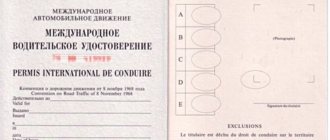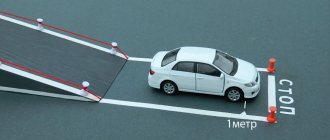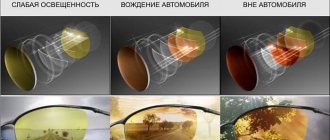Home / Situations
Back
Published: December 27, 2019
Reading time: 3 min
1
6636
When driving a car, it is important to correctly assess the situation on the road. Therefore, when undergoing a medical examination, the driver is examined according to the scheme established by law. Some of the most important indicators are vision and hearing. But what if these functions are not 100% accurate? Let's figure out whether you can count on getting a driver's license with poor eyesight, and whether deaf and deaf-mute people can drive.
- Visual impairments to obtain a license For categories A and M
- For category B
- For categories C, CE, D, DE
Dear readers! To solve your problem, call hotline 8 or ask a question on the website. It's free.
Ask a Question
Vision requirement for driver's license
Assessment of vision to obtain a medical certificate on suitability to drive a vehicle is carried out according to several criteria: acuity, color vision, horizons, etc.
Acuity
According to Order of the Ministry of Health and Social Development of Russia No. 302n , minimum thresholds for visual acuity have been established, which are differentiated depending on the category of driver's license.
Thus, for drivers of categories A and B, whose driving is not related to professional activity, it is required that:
- vision was from 0.6 and above in one eye and from 0.2 and above in the second;
- if one of the eyes is blind, the vision of the second was not lower than 0.8 (any correction is possible);
- a month has passed since the eye refractive surgery .
For professional drivers of all categories, the requirements for visual acuity are higher:
- the vision of one eye should be from 0.8 , and the second – from 0.4. The total score of both eyes should be 0.7 or higher;
- The use of correction means exceeding 8 diopters in both positive and negative directions is excluded. The difference in visual acuity of both eyes should not be more than 3 diopters;
- if a person has astigmatism, then the sum of the cylinder and sphere cannot exceed 8 diopters. The difference in visual acuity of both eyes should not be more than 3 diopters;
- if one eye does not see, the second should see without correction means from 0.8 and above.
- It is not permissible to have chronic eye diseases that create obstacles to the normal functioning of the visual apparatus and cannot be treated (paralytic strabismus, eyelid injuries, etc.), as well as spontaneous nystagmus (eyeballs are located with a deviation of 70% or more from their normal position ).
Color perception
Diagnosis of color perception is a mandatory procedure when opening a driver’s category.
This criterion did not always exist. Today, violation of color perception is the basis for a ban on driving a vehicle professionally.
Since 2012, a complete lack of color perception (achromatopsia) excludes the possibility of fully driving a vehicle, i.e. A positive medical report for a person to obtain a driver's license is excluded.
Determining the degree of color perception distortion forms the basis for the conclusion on the issuance of a certificate for obtaining a driver’s license.
Even with color vision impairments, it is possible to receive it. A corresponding note is made in the certificate.
Medical contraindications for vision for drivers: eye diseases
There are certain diseases of the organ of vision in which the driver may be refused and not sign the bypass sheet:
- glaucoma (depending on the severity and stage);
- retinal detachment;
- inflammatory disease of the lacrimal sac (after surgery, permission is issued);
- optic nerve diseases;
- splitting of objects (diplopia);
- pathological change in the mucous membrane and muscles of the eyelid, which interferes with normal visibility.
More on AutoLex.Net:
Tractor driver's license in 2020: how to get, replace?
Also, the driver may not be given permission if 3 months have not passed since the eye surgery.
Level of color perception
Diagnostics are based on Rybkin’s polychromatic tables - sheets with images of elements, most often numbers, made in the same brightness, but different in color.
If a person has color vision impairments, then the image appears to him to be made in one color.
For people with normal vision, distinguishing the image is not difficult. The more images are not recognized or are recognized with errors, the stronger the degree of the defect (in mild forms of color vision disturbance one or two shades of color are not recognized, in more severe forms - more).
Color blindness today cannot be treated or corrected.
Horizon
Visual impairment is not common and occurs in people with serious illnesses. The fact of having a narrowed horizon creates an obstacle to obtaining a driver’s license, and more often makes it impossible altogether.
Field of View Width
The width of the visual field is also included in the assessment of a person's suitability to drive a vehicle.
It should not be limited to 20 degrees or more horizontally and vertically.
The process develops both spontaneously and gradually. In this state, you can only see what is directly in front, as if you were looking through a pipe. The narrowing of the field of view cannot be corrected with lenses or glasses.
Eye disease
Diseases that affect your horizons are different. For example, retinal detachment. This disease manifests itself in the form of a “curtain or veil before the eyes.” Timely diagnosis of the disease makes it possible to reverse the process.
Another disease is glaucoma.
It manifests itself in the form of sharp pain in the eyeball with simultaneous blurring, redness of the mucous membrane, nausea or vomiting. With these types of diseases, you need to sound the alarm at the first symptoms and go to the doctor, since their development can lead to blindness and even removal of the eyeball.
Don't know what to do if you lose your rights? Read about this in the article: what to do if you have lost your license. Details about how long a certificate for a driver’s license is valid are written here.
What other indicators are taken into account during a vision test?
No less important is the color perception indicator. To check it, the Rabkin table is used.
If, based on the results of the test, it turns out that the driver has impaired color vision for green and red, the issuance of a driver's license will be denied, since it is believed that the driver will not be able to distinguish between the colors of the traffic light.
Despite the fact that in practice this defect does not interfere with distinguishing traffic lights, because the driver remembers the switching sequence, obtaining a license with such a deviation is prohibited. In some countries, to solve this problem, they plan to use different forms of lamps for traffic lights to eliminate the possibility of confusing signals for drivers with such a defect.
Categories “B” and “C” can be opened with minor deviations, provided that the applicant distinguishes the colors of the traffic light.
Another indicator of normal vision function that gives permission to drive is horizons. Narrowed vision of the eyes is usually a symptom of certain diseases. If it is present, the view is extremely narrowed. According to standard indicators, it should not be less than 20 degrees. This defect cannot be corrected with the help of corrective devices, just like color blindness. Therefore, if the indicators are exceeded, the subject will not receive permission to drive.
Steps to pass a medical examination
Passing a medical examination requires obtaining an appropriate certificate. Without it, obtaining a driver's license, as well as studying at a driving school, is impossible. The category of rights received does not matter.
If you are in any doubt about the level of vision required for a driving licence, it is best to contact a qualified optometrist in advance.
After the examination, if deviations from the norm are detected, it is worth resorting to corrective measures as prescribed by a specialist. For the medical examination, it is required that the corrective means used correspond to the visual acuity and other indications, otherwise it will not be possible to obtain a medical certificate for a driver’s license.
If a specialist advised you to take a course of vision stimulation using a special device. It is also worth following the recommendations.
When undergoing a driver's medical examination, it is worth considering that at different times of the day, visual acuity may change, since different factors influence it. On the eve of the medical examination, you should avoid eye strain and relieve them as much as possible, not only physically, but also psychologically.
Acceptable visual acuity values
The conclusion of the medical commission and, accordingly, the right to drive a car or other mechanical vehicle are issued to drivers who have no contraindications. In these individuals, the acuity index should be within normal limits.
Regarding what minimum vision is acceptable to obtain a driver's license:
- For category B. Sharpness must be no less than 0.2 units in one eye and no less than 0.6 in the other.
- For category C. The norm is no less than 0.8 in one eye and no less than 0.4 units in the other.
- For categories A, A1 and B2. Visual acuity should be at least 0.6 units in one eye and at least 0.2 in the other.
In some cases, blindness in one eye is diagnosed. In such situations, an acceptable value for another is an indicator of at least 0.8 units.
If the acuity of both eyes is the same (that is, there is no dominant one), the norm for them is a level of at least 0.7.
READ MORE: Revocation of a driver's license for alcohol in 2020
Driving ban
There are visual impairments that prevent you from obtaining a driver's license of any category.
These restrictions are prescribed by the Ministry of Health and, in fact, if at least one is present, driving, and, accordingly, obtaining a license, is prohibited.
Base
Grounds for driving ban:
- 3-month period from the moment of successful eye surgery;
- there are persistent changes in the mucous membrane of the eyelid muscles, which negatively affects the quality of vision. Surgical intervention makes it possible to eliminate the defect and obtain rights;
- there are disorders of the lacrimal sac. Surgical intervention makes it possible to eliminate the defect and obtain rights;
- glaucoma, taking into account the degree and severity;
- diplopia due to strabismus;
- retinal detachment;
- optic nerve atrophy.
Primary document
The primary document is a medical certificate. It is issued only in cases of successful completion of the medical examination, i.e. the person’s state of health meets the established criteria and there are no grounds for a ban on driving.
A sample document is presented here.
The medical commission is required to be completed at a certain frequency, which depends on the category, type of activity and initial conclusion.
If during one of the ongoing medical examinations after obtaining a driver’s license, the state of health and vision changes and obstacles to driving a vehicle appear, the driver’s license loses its validity for the period of the presence of obstacles (either for life or until recovery).
In any case, the driver must have a valid certificate throughout the entire period of driving.
How to check the validity of a driver's license? See the article about this: checking your driver's license. How to obtain a driver's license for migrants is written here.
Everything about driving license suspension is presented here.
Driver's License Stamp (GCL)
If, as a result of an examination by an ophthalmologist, a visual impairment was identified that allows a person to drive a vehicle, but requires the use of special means (glasses, lenses), then a note is entered on the driver’s license. A special designation was introduced in 2014 and is a combination of three letters - GCL.
If there is a GCL mark and the fact of driving without glasses or lenses, the motorist will be fined. Such a violation does not require a separate article and is equivalent to driving without a license.
Cost of a driver's license certificate.
Commission vision testing for future drivers
A variety of health checks, including eye assessments, are carried out for drivers in order to ensure safety for all participants while driving on roads. Good vision helps to drive a car in strict accordance with the rules. If there are problems with the condition of the eyes, the enterprise simply becomes dangerous - this increases the likelihood of emergency situations and significantly increases the risk of injury.
If vision does not correspond to the norm, drivers have an increased chance of causing an accident or causing one by incorrectly assessing the situation on the road. Therefore, it is necessary to be attentive to the health of the visual organs if a person wants to drive independently. During a medical examination by an ophthalmologist, the following possibilities are assessed:
- Degree of color sensations;
- Line of sight;
- Visual acuity.
To correctly determine visual acuity, the Sivtsev table is used. It uses the Russian alphabet; on the poster the signs are placed so that in each line their size is slightly smaller. The subject is placed at some distance in front of the table, from where he will have to read the letters indicated by the specialist. Visual acuity will be determined by which of the rows he can accurately identify the letters.
To obtain results during eye tests, the Golovin table can also be used - it uses rings arranged in 12 rows and gradually decreasing in size. The test is carried out as follows: the specialist asks the subject to name some signs, which he himself will point out. When working with such a table, the candidate driver will have to indicate on which side of the ring the gap is located.
If there are problems in this area, some even try to memorize the vision table for drivers. This is not difficult to do - it uses only a few letters of the Russian alphabet. But the deception will most likely be unraveled. In addition, if incorrect information is provided as a result of an erroneous inspection, many people experience problems during subsequent inspections.
If a test is carried out by an eye doctor for a driver's commission, and the subject wears lenses or glasses, he will have to read the letters from the material without removing them. The certificate issued based on the results will indicate that the vision indicators were recorded for the person while using corrective devices. It must be borne in mind that obtaining a vision permit for drivers wearing glasses or lenses obliges them to drive a car only with the use of corrective elements. If you don't have them, you can get a fine for a considerable amount - driving without glasses for people with vision problems is almost equivalent to driving without a driver's license.
A little about everything
Photo of car license
Every year the number of car enthusiasts is growing. After all, nowadays a car is not a luxury, but just a means of transportation. For this reason, many driving schools are simply overcrowded with people who want to learn and get a license.
However, to issue a driver's document, you must not only know the traffic rules well, but also pass a medical examination. This is where many citizens face numerous difficulties. In particular, this is due to the fact that the medical commission includes an ophthalmologist who cannot allow a person with poor vision to drive a vehicle.
This is important to know
So with what kind of vision will a person be allowed to drive a car? This is a very interesting question. So, a person will definitely be allowed to drive a vehicle if his visual acuity in both eyes is at least 0.7 units. You need to know about this.
Examination by an ophthalmologist
Checking with an ophthalmologist is an important condition, without which documents cannot be issued. This is necessary both for the motorist so that he does not create accidents on the roadway, and for other motorists and pedestrians.
If vision is imperfect, for example, a person is unable to see a walking person or an obstacle. Because of this, accidents of varying levels of severity occur.
Therefore, an examination by an ophthalmologist ensures complete safety on the road. That is why doctors pay special attention to this point.
Assessment of horizons
Good visual acuity is not enough to obtain a driver's license. The horizon indicator must be at least 20 degrees. If it is narrower, the person is not allowed to drive the vehicle.
It is important to understand that a small indicator of horizons often indicates the development of a pathological process. For example, it often accompanies the course of glaucoma and cataracts. In addition, narrowing of vision is often a symptom of retinal detachment. All of the above pathologies are absolute vision limitations for obtaining a driver's license.
At the same time, a person is not prohibited from contacting a medical institution with a request to have an operation. After a successful surgical intervention, it is permissible to undergo a medical examination again. If all vision contraindications for obtaining a driver’s license are excluded, including the restoration of normal acuity, the doctor no longer makes a note that the person wears any corrective devices.
Full medical examination procedure
The candidate can undergo the medical examinations necessary for admission to take a training course at a driving school at any of the specialized institutions. The only important factor is the fact that the clinic must have a state certificate for qualified medical examinations.
If you have serious chronic diseases or pathologies, you must take with you a card containing medical records and extracts from the medical history. A detailed study of this information will allow specialists to make a reasoned and most correct conclusion regarding the ability to drive a car.
Basically, the price depends on the region and level of the hospital you decide to go to.
Depending on the results of the inspection, a certificate for obtaining a license to drive a personal vehicle is issued for the following period:
- 3 years - for drivers of personal cars without any health impairments.
- 2 years - for people who plan to work as drivers of freight or passenger transport.
- 1 year - for persons applying for a license who have not reached 20 years of age or are over 50 years of age.
- If an applicant driver exhibits deviations from normal health indicators, then a license is also issued for a period of no more than 1 year.










